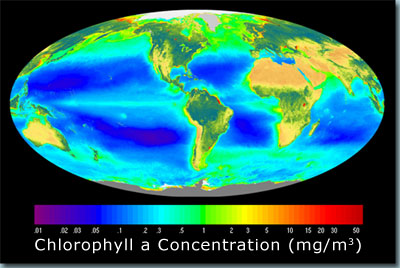Why was the OSMOSIS project created?
The OSMOSIS project was created to improve our understanding of the physical processes which take place in the upper ocean. Below, we set out why these processes are important for both ecosystems both in the water and on land. Before looking at these, we need to see the structure of the upper ocean.
How the upper ocean works
Although its temperature and salinity vary widely throughout the planet, the basic characteristics of the upper ocean are surprisingly universal. Broadly speaking, it is composed of a surface layer where the temperature and salinity are almost uniform and so this part is called the mixed layer. The mixed layer typically lies above a layer where temperature decreases sharply with depth, so this layer is called the thermocline (where 'thermo' refers to temperature and 'cline' has the same root as the word 'decline', meaning a change in something. [These properties can be seen in the figure below showing temperature profiles from the OSMOSIS observation site].
The reason the upper ocean tends to have a mixed layer and thermocline structure is relatively simple. It is due, firstly, to the wind blowing over the surface, which sets off churning turbulent motions near the surface that mix the water there. Secondly, it arises when the surface water is chilled (say at night or in winter) so that it becomes colder and heavier than the water below. This is an unstable arrangement and so convection will generally start and continue until a stable arrangement with a uniform temperature is arrived at.
Impact of physical processes on marine life
This arrangement of a mixed layer above a thermocline has huge implications for marine life. This is because almost all of the sunlight - which is needed for photosynthesis by marine plants - is in the mixed layer. However, many other nutrients required for life have a tendency to be slightly heavier than water and so sink out of the mixed layer into the thermocline. Unfortunately, the thermocline water is heavier than the mixed layer water and so it is difficult to mix these nutrients back into the sunny mixed layer. This is the paradox of the ocean for marine ecosystems - how to generate life when the light and nutrients are found in different places.
One way this conundrum is overcome is in areas where exchanges between the mixed layer and thermocline are strongest. Strangely, these are often the same sub-polar and polar regions that we associate with the least-productive land-based systems. So, for example, one of the world's richest fishing grounds in the Barents Sea, which is further north than any forest grows in Siberia. The exchange between the mixed layer and thermocline is strong here, because of the mixing brought about by the intense cooling and storms with ferocious winds. These also make it quite unpleasant to go fishing!
 Marine productivity map: A global map of chlorophyll (indicating marine productivity) estimated using the NASA SeaWIFS satellite
Marine productivity map: A global map of chlorophyll (indicating marine productivity) estimated using the NASA SeaWIFS satellite
Swapping heat with the atmosphere
The upper ocean is also important for our day-to-day lives. In northern Europe, our weather tends to arrive from over the ocean. Winds which blow over the ocean exchange heat with it. If the air is warmer than the ocean, then the air is cooled. Conversely, if the air is colder than the ocean, then the air is warmed by its passage over the waves.
This exchange of heat makes it important for weather forecasters to understand. If the ocean mixed layer is shallow and colder than the wind, then it will warm quickly and so extract relatively little heat from the air. If it is deep, on the other hand, it could absorb quite a bit more heat from the air before reaching a balance in temperature with the wind. In this case it could affect the forecasted temperature.


